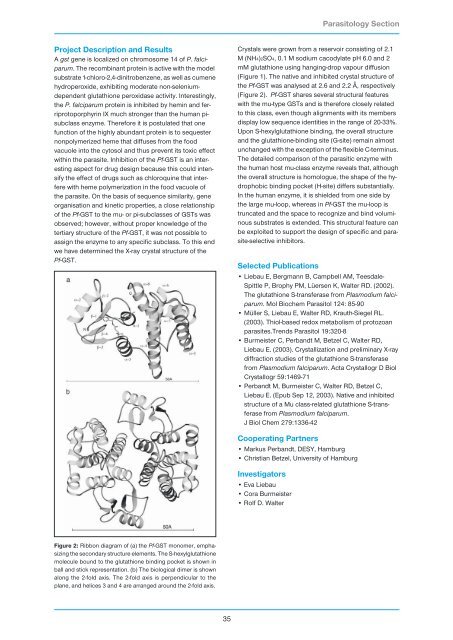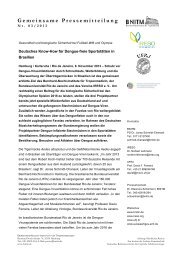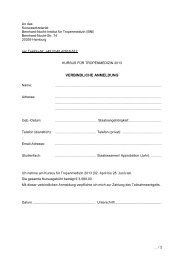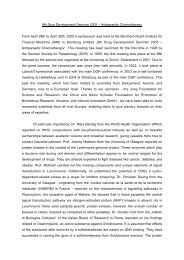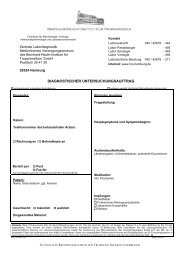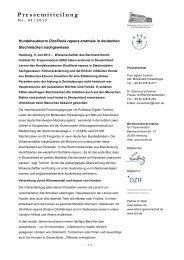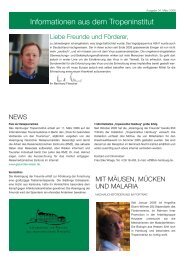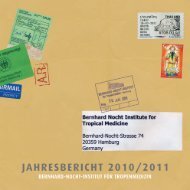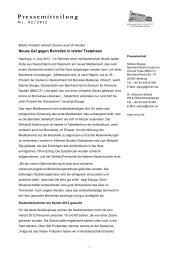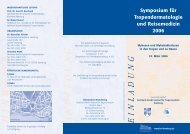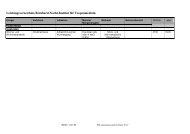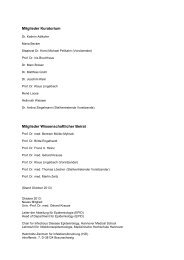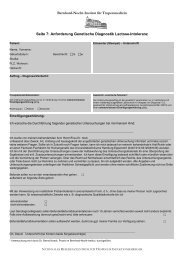Research Group Heussler (Malaria I) - Bernhard-Nocht-Institut für ...
Research Group Heussler (Malaria I) - Bernhard-Nocht-Institut für ...
Research Group Heussler (Malaria I) - Bernhard-Nocht-Institut für ...
Create successful ePaper yourself
Turn your PDF publications into a flip-book with our unique Google optimized e-Paper software.
Project Description and Results<br />
A gst gene is localized on chromosome 14 of P. falciparum.<br />
The recombinant protein is active with the model<br />
substrate 1-chloro-2,4-dinitrobenzene, as well as cumene<br />
hydroperoxide, exhibiting moderate non-seleniumdependent<br />
glutathione peroxidase activity. Interestingly,<br />
the P. falciparum protein is inhibited by hemin and ferriprotoporphyrin<br />
IX much stronger than the human pisubclass<br />
enzyme. Therefore it is postulated that one<br />
function of the highly abundant protein is to sequester<br />
nonpolymerized heme that diffuses from the food<br />
vacuole into the cytosol and thus prevent its toxic effect<br />
within the parasite. Inhibition of the Pf-GST is an interesting<br />
aspect for drug design because this could intensify<br />
the effect of drugs such as chloroquine that interfere<br />
with heme polymerization in the food vacuole of<br />
the parasite. On the basis of sequence similarity, gene<br />
organisation and kinetic properties, a close relationship<br />
of the Pf-GST to the mu- or pi-subclasses of GSTs was<br />
observed; however, without proper knowledge of the<br />
tertiary structure of the Pf-GST, it was not possible to<br />
assign the enzyme to any specific subclass. To this end<br />
we have determined the X-ray crystal structure of the<br />
Pf-GST.<br />
Figure 2: Ribbon diagram of (a) the Pf-GST monomer, emphasizing<br />
the secondary structure elements. The S-hexylglutathione<br />
molecule bound to the glutathione binding pocket is shown in<br />
ball and stick representation. (b) The biological dimer is shown<br />
along the 2-fold axis. The 2-fold axis is perpendicular to the<br />
plane, and helices 3 and 4 are arranged around the 2-fold axis.<br />
35<br />
Crystals were grown from a reservoir consisting of 2.1<br />
M (NH4)2SO4, 0.1 M sodium cacodylate pH 6.0 and 2<br />
mM glutathione using hanging-drop vapour diffusion<br />
(Figure 1). The native and inhibited crystal structure of<br />
the Pf-GST was analysed at 2.6 and 2.2 Å, respectively<br />
(Figure 2). Pf-GST shares several structural features<br />
with the mu-type GSTs and is therefore closely related<br />
to this class, even though alignments with its members<br />
display low sequence identities in the range of 20-33%.<br />
Upon S-hexylglutathione binding, the overall structure<br />
and the glutathione-binding site (G-site) remain almost<br />
unchanged with the exception of the flexible C-terminus.<br />
The detailed comparison of the parasitic enzyme with<br />
the human host mu-class enzyme reveals that, although<br />
the overall structure is homologue, the shape of the hydrophobic<br />
binding pocket (H-site) differs substantially.<br />
In the human enzyme, it is shielded from one side by<br />
the large mu-loop, whereas in Pf-GST the mu-loop is<br />
truncated and the space to recognize and bind voluminous<br />
substrates is extended. This structural feature can<br />
be exploited to support the design of specific and parasite-selective<br />
inhibitors.<br />
Selected Publications<br />
• Liebau E, Bergmann B, Campbell AM, Teesdale-<br />
Spittle P, Brophy PM, Lüersen K, Walter RD. (2002).<br />
The glutathione S-transferase from Plasmodium falciparum.<br />
Mol Biochem Parasitol 124: 85-90<br />
• Müller S, Liebau E, Walter RD, Krauth-Siegel RL.<br />
(2003). Thiol-based redox metabolism of protozoan<br />
parasites.Trends Parasitol 19:320-8<br />
• Burmeister C, Perbandt M, Betzel C, Walter RD,<br />
Liebau E. (2003). Crystallization and preliminary X-ray<br />
diffraction studies of the glutathione S-transferase<br />
from Plasmodium falciparum. Acta Crystallogr D Biol<br />
Crystallogr 59:1469-71<br />
• Perbandt M, Burmeister C, Walter RD, Betzel C,<br />
Liebau E. (Epub Sep 12, 2003). Native and inhibited<br />
structure of a Mu class-related glutathione S-transferase<br />
from Plasmodium falciparum.<br />
J Biol Chem 279:1336-42<br />
Cooperating Partners<br />
• Markus Perbandt, DESY, Hamburg<br />
• Christian Betzel, University of Hamburg<br />
Investigators<br />
• Eva Liebau<br />
• Cora Burmeister<br />
• Rolf D. Walter<br />
Parasitology Section


